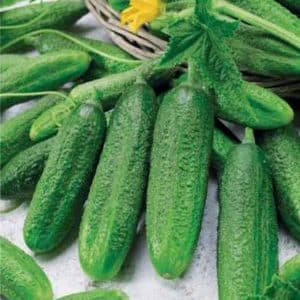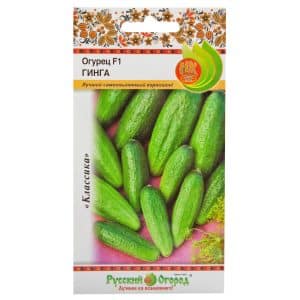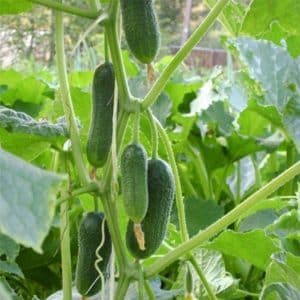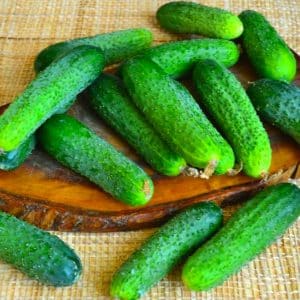Hybrid cucumber "Ginga f1" from German breeders
Ginga f1 cucumbers are a crop supplied to the Russian market by the German agricultural company Satimex Quedlinburg. Even novice gardeners can cultivate such a plant.
There are no particular difficulties in the process of growing a hybrid, and the results will exceed your wildest expectations. The fruits tolerate transportation well, which has captivated many farmers.
Description of cucumbers
Ginga f1 cucumbers were bred by German breeders and belong to plants with an average ripening period. The hybrid was included in the State Register of the Russian Federation in 2002 for garden plots and farms; it can be grown in any region of Russia. Cultivation on an industrial scale is recommended.
Distinctive features
Ginga belongs to the parthenocarpic type, that is, it is pollinated without the participation of insects. It has a female type of flowering. It is characterized by abundant yield and disease resistance. Suitable for greenhouses, can also be planted directly in open ground. The hybrid has been adapted for growing without the use of shelters.
Attention! Seeds can be planted dry, without prior germination.
Composition, properties, benefits, calorie content
The fruits of the plant contain many useful substances. They are low in calories, remove toxins from the body and help fight excess weight, and are 95% water. There are 10-15 kcal per 100 g. Cucumbers are good for the body in any form.
Characteristics
The Ginga hybrid bushes are of the indeterminate type and reach a height of 2.5 meters.The leaves are small and green in color. The first fruit is formed 60 days after the appearance of the first shoots.
Cucumbers are cylindrical in shape, with dark green skin. Small tubercles are formed on them in large numbers, which are covered with light down. The fruits show dark spots, short stripes and spines. Weight reaches 90 g.
The average diameter is 3 cm. The pulp does not contain large seeds, it is crispy and dense, with a taste characteristic of cucumbers, without bitterness. The yield reaches 3–6 kg from each bush.
How to grow a hybrid yourself
Ginga f1 is adapted for cultivation in open ground and in a greenhouse. To obtain an earlier harvest, the seedling method is used. It is possible to sow seeds directly into open ground.
The choice of planting option is always up to the gardener, but, regardless of the method, growing a hybrid brings excellent results.
Planting by seeds and seedlings
In open ground, cucumbers are grown mainly through seedlings. This helps to achieve higher yields than when sowing directly into the ground. Seeds are planted at the end of April. For planting, you can use cups with a depth of at least 10 cm or common boxes. Sowing in a separate container will avoid picking, which has a bad effect on young plants.
Sow seeds in loose soil. Ready-made mixtures for growing flowers are well suited. When preparing the soil yourself, mix peat, turf soil and vermiculite in equal proportions. The last ingredient can be replaced with river sand. Nitrophoska and wood ash are added to this substrate.
Before sowing, the soil should be sterilized. There are three ways to do this:
- Soak with potassium permanganate solution.

- Heat in the oven for half an hour at a temperature of no more than +125 °C.
- Keep for 2-3 days in the freezer at temperatures down to -25 °C.
After sterilization, the soil must be kept for a week, maintaining room temperature.
You will also need to prepare the seeds for sowing. They are disinfected in a solution of potassium permanganate for half an hour, then kept at a temperature of +20 ° C in a damp cloth for 48 hours.
Cucumbers are sown in furrows up to 4 cm deep, maintaining a distance of 6 cm between rows. The seeds are sprinkled with soil and watered well.
In the process of growing seedlings, you should ensure:
- maintaining ambient temperature +22–26 °C;
- watering every four days;
- loosening the soil;
- additional lighting.
After the seedlings reach a height of 15–20 cm and form 4-5 leaves, the plant is planted in open ground. This usually happens 25 days after sowing the seeds.
Important! Please note that the ambient temperature should not be less than +15 °C.
When planting cucumbers in the garden, they adhere to the 40x50 pattern (holes-rows). Passages approximately one meter wide are left every two rows.
Growing and care
Hybrid Ginga does not require special growing conditions. The plant needs watering, timely fertilization of the soil and garter.
Water the cucumbers regularly, at least once a week. Do not allow the soil to become waterlogged - this can lead to rotting of the roots and death of the bush.
When the plant has 10 leaves, you can start watering more frequently, 2-3 times a week. The soil should be constantly moderately moist. If this condition is not met, the fruits may become bitter. During dry days, cucumbers are watered daily.
 Fertilizers begin to be applied when at least seven leaves are formed on the plant. In the first feeding there should be an increased nitrogen content. To do this, use a solution of cow manure or chicken droppings. The second time, fertilizers are applied at the time of flowering: a mineral mixture is prepared from superphosphate, ammonium nitrate and potassium nitrate. The solution is used to produce root watering.
Fertilizers begin to be applied when at least seven leaves are formed on the plant. In the first feeding there should be an increased nitrogen content. To do this, use a solution of cow manure or chicken droppings. The second time, fertilizers are applied at the time of flowering: a mineral mixture is prepared from superphosphate, ammonium nitrate and potassium nitrate. The solution is used to produce root watering.
It is also necessary to feed the hybrid with potassium and phosphorus at the time of fruiting. Superphosphate is best suited for this purpose. Fertilizing is done every 10 days, always in dry weather.
Cucumbers need to be tied when 7 leaves appear. A peg is installed near the plant or each bush is attached with twine to a common rod at a height of 2 m.
Features of cultivation and possible difficulties
Particular attention is paid to the formation of the bush. Without this, it will be difficult to obtain high yields; the fruits will take longer to ripen.
Formation is carried out in the following way:
- near the first two sheets, the lateral growth points are removed;
- in the middle of the stem, the growing points in the zone of 3-4 nodes are removed and two leaves and two shoots are left;
- No more than three shoots are left at the top of the bush. If necessary, thin out the top of the plant.
Resistance to diseases and pests
When breeding a hybrid, the breeders had a goal to achieve resistance to diseases and pests. Ginga f1 has strong immunity to diseases common to cucumbers. However, if the plant is not properly cared for, there is a possibility of development in the garden. fusarium.
Of all the known pests, the crop can be attacked by aphid. It is important to quickly respond to the appearance of a disease or insects and take measures to preserve the plant.
Harvesting and application
The appearance of the first harvest can be expected 45–60 days after germination. Fruits should be collected every 2-3 days. At the peak of fruiting, cucumbers are harvested every day. For long-term storage cucumbers are placed in the refrigerator: at a temperature of no more than -5 ° C, the fruits can quietly lie for 2-3 weeks without losing their taste.
Ginga cucumbers are well suited for transportation. Good both fresh and for winter preparations.
Advantages and disadvantages of the variety
The hybrid has a number of positive properties:
- good yield;
- early harvest;
- universal use of fruits;
- not susceptible to many diseases;
- great taste;
- marketable appearance of the fruit.
During the cultivation of the hybrid, no serious deficiencies were found. The disadvantages include the cost of forming bushes and the high price of seeds.
Reviews
Reviews about the hybrid are mostly positive. Gardeners are satisfied with the high percentage of germination, excellent taste and long-term storage.
Alevtina, Starorussky: «It is a very big plus that the Ginga hybrid has such a short gap from germination to harvest. The cucumbers grew beautiful and even. The taste is beyond praise."
Nina, s. Podgornoe: “I fell in love with these cucumbers at first sight. The fast germination and long storage of the fruits of the Ginga hybrid were pleasantly surprising. A big plus during the dry summer season was that there was no need for daily watering.”
Conclusion
The Ginga hybrid can bear fruit in areas with any climate and is characterized by high yield. Thanks to this, cucumbers can be used not only in households, but also in industries.
The fruits are universal, so for gardeners who prepare for the winter and love fresh vegetables, this hybrid will come in handy. There are no difficulties in cultivation, and the results exceed all expectations.